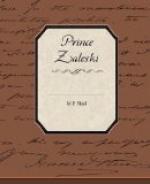’But you start—you are troubled—you never heard or read of murder such as this, the simultaneous murder of thousands over wide areas of the face of the globe; here you feel is something outside your experience, deeper than your profoundest imaginings. To the question “by whom committed?” and “with what motive?” your mind can conceive no possible answer. And yet the answer must be, “by man, and for human motives,”—for the Angel of Death with flashing eye and flaming sword is himself long dead; and again we can say at once, by no one man, but by many, a cohort, an army of men; and again, by no common men, but by men hellish (or heavenly) in cunning, in resource, in strength and unity of purpose; men laughing to scorn the flimsy prophylactics of society, separated by an infinity of self-confidence and spiritual integrity from the ordinary easily-crushed criminal of our days.
’This much at least I was able to discover from the first; and immediately I set myself to the detection of motive by a careful study of each case. This, too, in due time, became clear to me,—but to motive it may perhaps be more convenient to refer later on. What next engaged my attention was the figures on the papyrus, and devoutly did I hope that by their solution I might be able to arrive at some more exact knowledge of the mystery.
’The figures round the border first attracted me, and the mere reading of them gave me very little trouble. But I was convinced that behind their meaning thus read lay some deep esoteric significance; and this, almost to the last, I was utterly unable to fathom. You perceive that these border figures consist of waved lines of two different lengths, drawings of snakes, triangles looking like the Greek delta, and a heart-shaped object with a dot following it. These succeed one another in a certain definite order on all the slips. What, I asked myself, were these drawings meant to represent,—letters, numbers, things, or abstractions? This I was the more readily able to determine because I have often, in thinking over the shape of the Roman letter S, wondered whether it did not owe its convolute form to an attempt on the part of its inventor to make a picture of the serpent; S being the sibilant or hissing letter, and the serpent the hissing animal. This view, I fancy (though I am not sure), has escaped the philologists, but of course you know that all letters were originally pictures of things, and of what was S a picture, if not of the serpent? I therefore assumed, by way of trial, that the snakes in the diagram stood for a sibilant letter, that is, either C or S. And thence, supposing this to be the case, I deduced: firstly, that all the other figures stood for letters; and secondly, that they all appeared in the form of pictures of the things of which those letters were originally meant to be pictures. Thus the letter “m,” one of the four “liquid” consonants, is, as we now write it, only a shortened form of a




